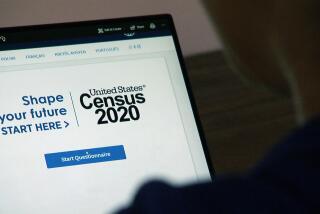Asians to surpass Latinos as largest immigrant group in U.S., study finds

Immigrants from 30 countries take part in a naturalization ceremony earlier this month at Liberty State Park in Jersey City, N.J.
Asians are likely to surpass Latinos as the nation’s largest immigrant group shortly after the middle of the century as the wave of new arrivals from Latin America slows but trans-Pacific migration continues apace, according to a new study of census data.
The surge of immigration that has reshaped the American population over the last half century will transform the country for several decades to come, the projections indicate. Immigrants and their children are likely to make up 88% of the country’s population growth over the next 50 years, according to the study by the Pew Research Center, which has tracked the effects of immigration on the country’s population for the last several decades.
The foreign-born, who made up just 5% of the nation’s population in 1965, when Congress completely rewrote the country’s immigration laws, make up 14% today, the study found. They are projected to be 18% of the population by 2065.
Increasingly, that population growth will involve Asians. Unlike the Latino population, which mostly shares a common language, Spanish, and many cultural traits, the census category of Asian takes in a vast array of ethnic and language groups, including Japanese, Chinese, Koreans, Filipinos, Indians and Pakistanis.
Already, Asian Americans make up about 6% of the nation’s population, up from just 1% in 1965. By the middle of the century they will total 14%, the projections say.
NEWSLETTER: Get the day’s top headlines from Times Editor Davan Maharaj >>
Asians are expected to constitute 36% of the immigrant population by 2055, surpassing Latinos, who by then will be 34% of immigrants, the study indicates. Since many Latinos are third- or fourth-generation Americans, they will remain a larger share of the total population, close to one-quarter of all Americans by midcentury.
Currently, Americans have a more positive view of Asian immigrants than of Latinos, according to a survey Pew did along with the population projections.
Nearly half of American adults, 47%, said immigrants from Asia have had a mostly positive effect on American society. Only 26% said the same about immigrants from Latin America, with 37% saying they thought the effects of Latin American immigration had been mostly negative. Immigrants from the Middle East fared worse in public opinion, with just 20% saying their effect on the country has been mostly positive, and 39% saying their impact has been mostly negative.
The survey found that 59% of Americans said immigrants, overall, were not learning English in a reasonable amount of time.
The Pew study was designed to look at how immigration has changed the racial and ethnic makeup of the U.S. since Congress passed the 1965 Immigration and Naturalization Act. That law abolished a quota system based on national origin, which had barred most immigrants from outside of western Europe and led to a sharp increase in immigration from Asia, Africa and Latin America.
Today, 62% of Americans are non-Latino whites, the report found. That’s down from 85% in 1965.
The survey found that people’s attitudes toward immigration depend on their political affiliation — with Democrats more favorable than Republicans — and also on whether a person knows an immigrant personally, said Mark Lopez, director of Hispanic research at Pew and a coauthor of the report.
“If you take a look at those who know someone who is an immigrant, fewer will say that crime and the economy are worse for it,” Lopez said.
He noted that the poll was conducted in the spring, before Republican presidential candidate Donald Trump sparked national debate with calls for much tougher immigration enforcement and criticism of some Mexican immigrants.
Among Democrats, 55% said immigrants were making American society better in the long run, while 24% said immigrants were making things worse.
Views were nearly the opposite among Republicans, 53% of whom said immigrants were making American society worse in the long run, and 31% saying they were making things better.
Younger Americans were more likely to see immigration as a positive thing, reflecting in part the ethnic diversity of their generation. According to the poll, 54% of Americans younger than 30 saw immigration as making the country better, while 27% said it was making the country worse. Those 65 and older split, 39% to 39%.
The questions were asked about immigrants in general, not only those who arrived in the U.S. illegally.
Overall, concerns about the effects of immigration were highest around crime and the economy. About half of Americans say immigrants have made crime worse and have hurt the economy.
On the other side, about half of Americans say immigrants have had a positive effect on American culture, improving food, music and the arts.
The survey has a margin of error of plus or minus 2.4 percentage points.
The report also noted that immigrants have changed significantly in recent years. They are more educated, for example. In 2013, almost half of all new arrivals from Mexico age 25 or older had completed high school, up from just 14% in 1970. More than 1 in 8 had a bachelor’s degree.
Among Asian immigrants, 57% of those age 25 or older who arrived in 2013 had a bachelor’s degree, up from 47% in 1970.
The increase reflects the greater levels of education in many parts of the world, the report said.
kate.linthicum@latimes.com
Twitter: @katelinthicum
ALSO
Boehner’s resignation may avert shutdown but emboldens renegades in GOP
‘God bless America,’ Pope Francis says as his U.S. visit comes to an end
Nature replants its own burned forests, environmentalists say
More to Read
Start your day right
Sign up for Essential California for news, features and recommendations from the L.A. Times and beyond in your inbox six days a week.
You may occasionally receive promotional content from the Los Angeles Times.







